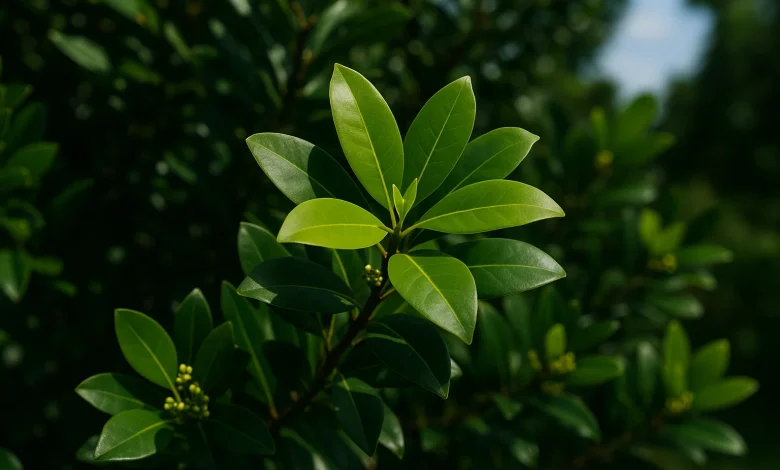Bay Leaves

Bay leaves in Dominica are the aromatic foliage of the West Indian bay tree (Pimenta racemosa), a signature plant of the island’s agricultural landscape and a foundational ingredient in the island’s globally recognised bay oil and bay rum industries. Traditionally harvested by hand in coastal and forest-edge communities, bay leaves have sustained rural livelihoods for over a century. Today, they support agro-processing, cultural tourism and value-added product development, while remaining a valued ingredient in local cuisine, herbal medicine and natural wellness traditions across Dominica.
Bay Leaves in Dominica’s Agricultural Heritage
Bay leaves form a vital thread within Dominica’s broader agricultural story. The leaves are primarily used in small-scale steam distillation processes to extract bay oil, an iconic export product with a spicy fragrance used in hair tonics, aftershaves and luxury colognes. This oil, when combined with high-quality rum and natural extracts, becomes Bay Rum, one of the island’s most famous value-added exports.
For generations, the cultivation and gathering of bay leaves has been rooted in rural communities such as Petite Savanne, Layou Valley, Soufrière, Syndicate, and Vieille Case. Before the climate-driven relocation of Petite Savanne, the village held the reputation of being Dominica’s largest source of bay leaves, with entire families engaged in seasonal harvesting, drying and hauling.
The industry is now anchored by the Dominica Essential Oils & Spices Co-operative Society Ltd, which processes more than 22,000 litres of bay oil each year and contributes roughly 75% of the global supply. This collaborative structure allows small farmers to earn a steady income while maintaining control over their ecological resources and production practices.
The Bay Tree: Growth and Ecology in Dominica
The West Indian bay tree (Pimenta racemosa) grows exceptionally well in Dominica’s fertile volcanic soils and tropical climate. Classified as an evergreen, it reaches heights of 7 to 12 metres and produces thick, glossy leaves with deep green pigmentation. The leaves emit a perfume-rich aroma when crushed, due to elevated eugenol levels, an essential oil component also found in cloves and cinnamon.
These trees thrive in moist, shaded environments and are often intercropped with citrus, cocoa, bananas or root vegetables. Farmers may cultivate them deliberately or allow them to regenerate naturally from seed in uncultivated spaces. Their presence improves soil stability on steep slopes, and the wood may also be harvested for local charcoal or firewood, making the tree a versatile contributor to rural life.
Harvesting, Distillation and Traditional Practices
Harvesting bay leaves is labour-intensive and often a multi-generational activity. Mature leaves are cut in bunches during the dry season, when oil concentrations are highest, and carried to roadside collection points. The leaves are either sold fresh or immediately used in distillation to prevent loss of fragrance compounds.
Distillation methods include:
- Traditional firewood stills, where leaves are boiled for hours under a copper or steel kettle
- Modern stainless-steel distillers, which allow safer, more controlled extraction
- Separation tanks, where the oil floats above the condensed water and is extracted by hand
These refined oils are filtered, graded for clarity and fragrance, and sold in 1-litre units or larger bulk drums to export markets. Oils produced in Dominica are renowned for their purity and potency.
Culinary and Medicinal Value
Beyond export markets, bay leaves remain part of daily Dominican life. In local cooking, they flavour fish broths, soups, stewed vegetables and one-pot dishes. Their herbal qualities lend depth to Creole cuisine, blending with thyme, onion and pepper to form a distinctly Dominican flavour palette.
In traditional medicine, bay leaf tea is used to soothe stomach upset, reduce inflammation, and aid sleep, making it one of the island’s most versatile bush remedies. The extracted oil is applied topically for muscle relief, chest congestion, or skin conditions, particularly in domestic remedies passed down through elders and herbal healers.
Value-Added Opportunities and Cultural Connections
Modern entrepreneurs are expanding the market for bay-based products by exploring:
- Herbal wellness tea kits
- Botanical soaps, salves and infused balms
- Artisan candles and fragrance diffusers
- Grooming kits featuring Bay Rum, bay oil and related skin-care items
These finished goods support Tourism in Dominica, appearing in eco-resorts, cultural gift shops, and boutique spas. Discover Dominica Authority and related agencies are also exploring tourism tie-ins, such as farm tours, distillery visits, and scent-making demonstrations, to help visitors connect with the island’s plant-based heritage.
Bay leaves represent an opportunity for sustainable, community-based industry development, especially when combined with value-added production and creative storytelling. As part of Dominica’s economic diversification, bay leaf production contributes both cultural value and export resilience.




